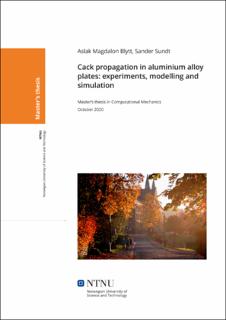| dc.contributor.advisor | Hopperstad, Odd Sture | |
| dc.contributor.advisor | Børvik, Tore | |
| dc.contributor.advisor | Espeseth, Vetle | |
| dc.contributor.author | Blytt, Aslak Magdalon | |
| dc.contributor.author | Sundt, Sander | |
| dc.date.accessioned | 2021-09-21T16:24:30Z | |
| dc.date.available | 2021-09-21T16:24:30Z | |
| dc.date.issued | 2021 | |
| dc.identifier | no.ntnu:inspera:69621544:32235599 | |
| dc.identifier.uri | https://hdl.handle.net/11250/2780075 | |
| dc.description.abstract | Denne masteroppgaven har studert sprekkpropagering i 1.5mm tykke plater av aluminiumslegeringen AA6016 utsatt for kvasisstatisk- og dynamisk last. Forsøkene har blitt modellert ved bruk av en FEA og en Gurson-Tvergaard-needleman (GTN) material modell til å beskrive plastisk materialoppførsel og brudd. Formålet med oppgaven er å bedømme nøyaktigheten, effektiviteten og robustheten til GTN-modellen til å predikere sprekkdannelse og sprekkpropagering i tynne aluminiumsplater. Oppgaven bruker data fra eksperimenter og tidligere forskning ved NTNU til å identifisere materialparameterne for tre tempers av AA6016: T4, T6 og T7. Forsøksdata fra strekktester på glatte prøvestykker har blitt brukt til å kalibrere flytespenning og isotropisk fastening, definert av Voce hardening rule. Data fra notched-strekk tester har blitt brukt til å bestemme skade- og bruddparametere til GTN-modellen. Cockcroft-Latham (CL) bruddkriterie har også blitt kalibrert for å sammenligne mot GTN-modellen. I oppgaven er det blitt utført strekktester på Double edged notched tension (DENT) tester ved institutt for konstruksjonsteknikk, NTNU. Samme test er deretter simulert ved hjelp av de identifiserte materialparameterene, og resultatene sammenlignet. Simuleringene er blitt utført i verktøyet Abaqus/Explisitt ved bruk av «8-node-linear-brick elements». Oppgaven finner at de numeriske resultatene ved bruk av begge modellene samsvarer godt med eksperimentell data. Modellene gir god nøyaktighet på krefter og forflynting, derimot er ikke korrekt sprekkpropagering predikert i alle testene. Gitt den enkle fremgangsmåten for kalibrering, og modellens beregningseffektivitet, støtter resultatene at modellen er et nyttig verktøy for dimensjonering av komponenter hvor fysiske tester er lite praktiske eller kostnadseffektive. | |
| dc.description.abstract | In this master’s thesis, crack propagation in 1.5mm thick AA6016 aluminium alloy plates exposed to quasi-static and dynamic load, has been investigated. Experiments have been modeled in Abaqus using solid elements and the Gurson-Tvergaard-Needleman (GTN) model to describe plasticity, damage, and fracture. The objective of the research was to evaluate the accuracy, efficiency, and robustness of the GTN model for simulating crack propagation in thin aluminium plates under quasi-static and dynamic loading conditions.
This paper addresses the procedures for calibrating the GTN-model parameters in addition to the extensively used Cockroft-Latham (CL) fracture criterion, for three tempers of AA6016 aluminum alloy. Data from five separate previously conducted experimental studies at NTNU have been used for parameter identification and model validation.
Uniaxial tensile tests were used to determine the flow stress and isotropic hardening, defined by the Voce-hardening law. Thereafter data from notched tensile tests were used to determine the damage and failure-parameters of the GTN and CL model. An experimental study was conducted on double edge notched tension specimens and subsequent simulations of the same test used as a final validation. All simulations were performed using Abaqus/Explicit using eight-node linear brick elements. The numerical results using both models were in good agreement with the experimental data with respect to forces and displacements, furthermore, crack initiation was rather accurately predicted, however, crack path results deviated in some experiments and neither model is able to capture the slant fracture mode observed in some of the tests. Considering the simplicity of the calibration process and the computational efficiency of the models, the results demonstrate, that when calibrated correctly, both models can be useful tools in the design of structures and components where physical tests are unpractical and costly. | |
| dc.language | eng | |
| dc.publisher | NTNU | |
| dc.title | Cack propagation in aluminium alloy
plates: experiments, modelling and
simulation | |
| dc.type | Master thesis | |
